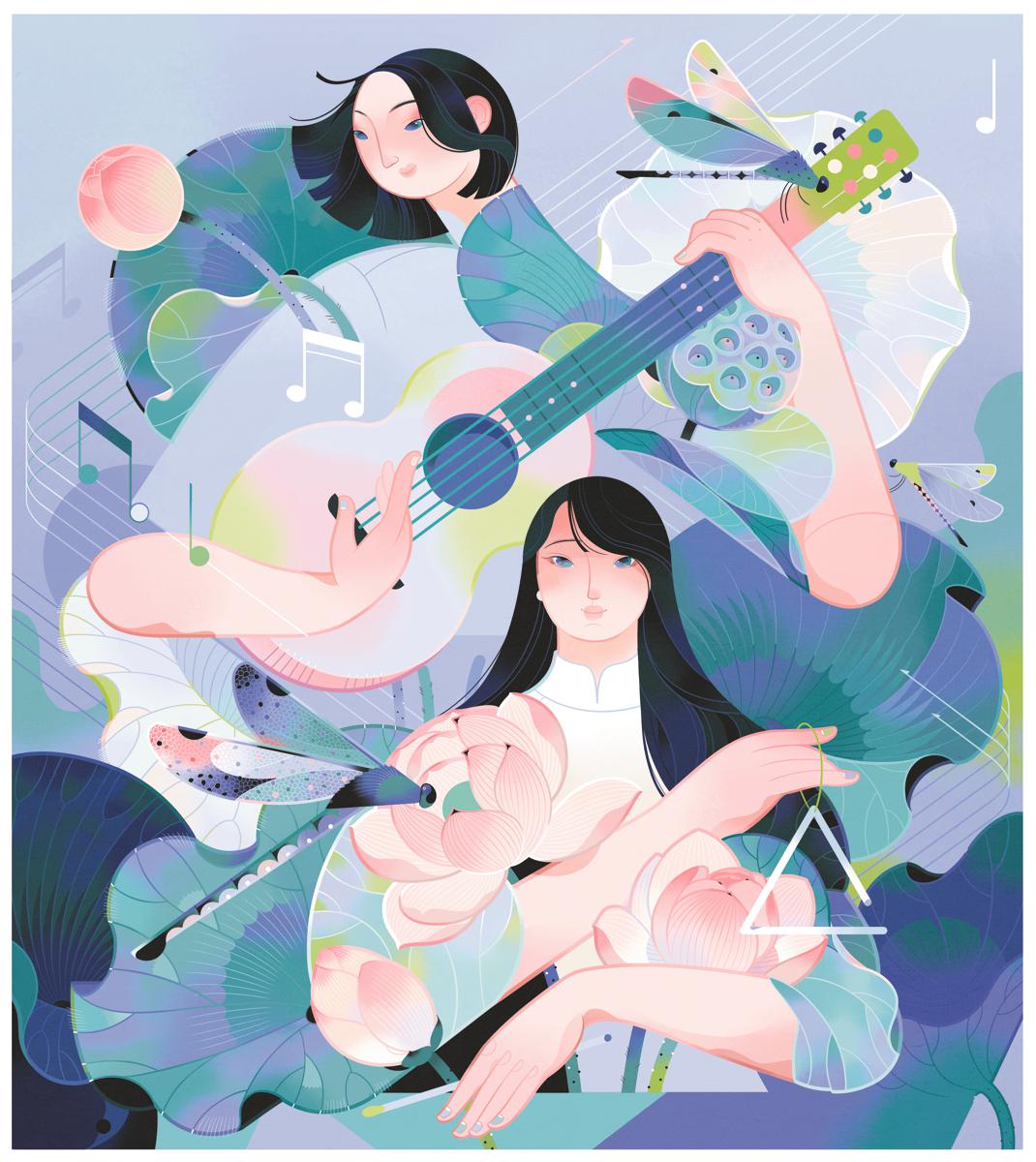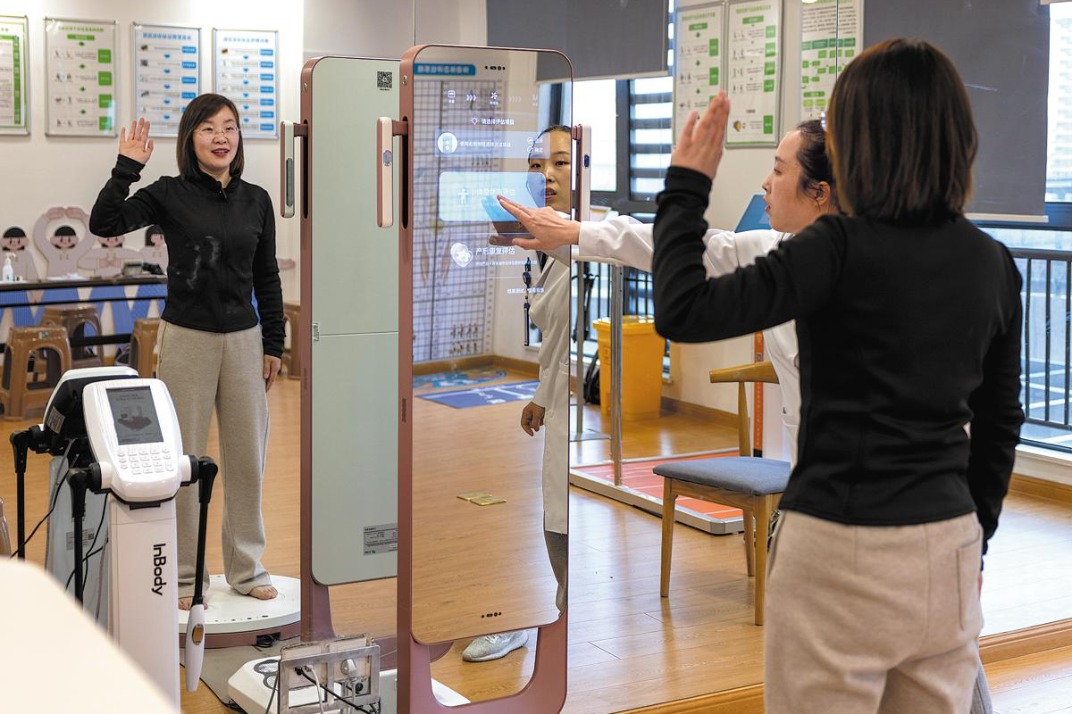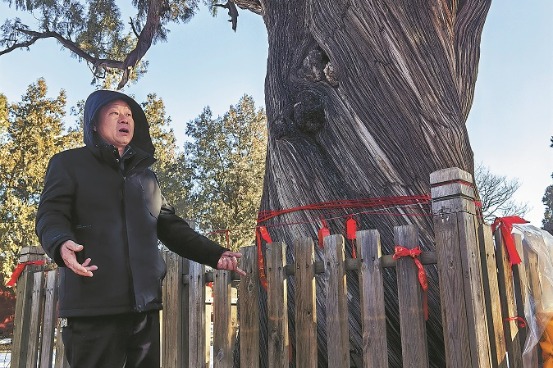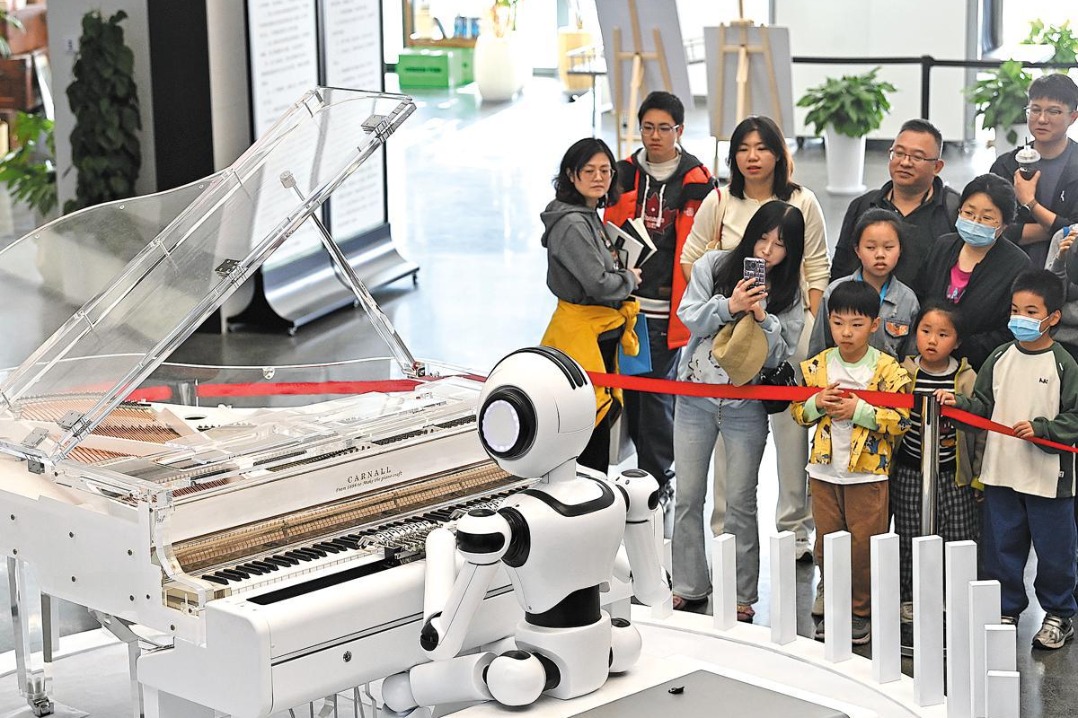Music therapy holds keys to healing
Treatment has vital role in palliative care, improving dementia


The therapy began with a simple greeting.
Wang Hanlin, strumming his guitar, gently played the opening notes of the Hello Song, and introduced himself with the lyrics: "Hello, my name is…."
Gu, a man in his 80s suffering from mild cognitive impairment — his condition makes him forget not only the names of loved ones, but even his own sometimes — was invited to complete the phrase.
Slowly, with some encouragement, he eventually uttered his name. This sparked an emotional response and signaled a shift from passive observation to active participation. It was a small, but crucial step in his rehabilitation.
In the corners of hospitals, nursing homes and rehabilitation centers, music therapy is tapping into the healing power of sound and rhythm.
Wang is a young music therapist who works in a nursing home in Beijing. He has been using songs and therapy initiatives to help spark seniors' memories, soothe their anxieties, and encourage social interactions.
Group sessions often begin with singalongs or playing a simple instrument, such as a drum. One-on-one sessions allow for more personalized musical experiences, whether it be the playing of a cherished tune or guiding one of the residents through a relaxation exercise.
"My job is a delicate balance of therapy and artistry, creating a space where music becomes a bridge to connect, comfort and bring joy to those living with the challenges of aging," said Wang, 35.
Hits and memories
For Gu, the next step in his therapy involved connecting the song to visual cues.
Gu's family had long been concerned about his memory lapses, such as forgetting his own name or events that had happened that day. Despite his forgetfulness, they noticed something intriguing — Gu would occasionally hum the tune of The Unfading Sun on the Grassland. The song had been his favorite when he was young, and worked in the Inner Mongolia autonomous region.
Wang recognized the healing potential of this song, and after discussions with Gu's family, he decided to design a music therapy plan centered around it.
The young therapist presented Gu with images of blue skies, wide-open grasslands, galloping horses, and soaring birds. Each scene was linked to a song lyric.
Wang encouraged the octogenarian to recall the lyrics that matched the pictures, and as Gu looked at the photographs fragments of memories were triggered.
"Blue skies, white clouds floating by," Gu began to sing, his voice shaky at first, then gaining strength.
With each session, Gu's ability to remember and sing the song's lyrics improved. Over time, he could sing the entire song without hesitation.
As Gu's connection to the song deepened, something extraordinary began to happen: his memory, which had been confined to a few disjointed moments, began to expand.
He started to recall more details, not just about the song, but about his entire life. The song unlocked a trove of forgotten memories, and enabled him to speak about important events from his past.
"Music can stimulate both emotional and cognitive responses in ways that are not possible through words alone," said Wang. "For patients with a cognitive impairment, music provides a unique way to connect the brain's neural pathways, often bypassing areas that have been damaged by age or illness."
"Music can reach parts of the brain that are often inaccessible through other therapies," he said.
Inspiring legacies
Music therapy began in the 20th century, when musicians played for World War I and World War II veterans in hospitals across the United States, said Liu Mingming, director of the Music Therapy Research Center at the Central Conservatory of Music in Beijing, who is responsible for teaching the music therapy program.
In 1980, music therapy was introduced to China for the first time when Professor Marjory Bong-Ray Liu, from the music therapy program at Arizona State University, gave a lecture on the topic at the Central Conservatory of Music in Beijing.
In 1996, China's first music therapist Gao Tian, who was certified by the American Music Therapy Association, returned to China from Temple University in the US. The same year, the Central Conservatory of Music established the Music Therapy Research Center.
In 1999, it began admitting master's students, and in 2003 started enrolling undergraduate students.
Since then, music therapy in China has matured and aligned with global standards.
Wang, from Liaoning province, said his music therapy calling began when he was a teenager.
During his third year of middle school he saw Gao being interviewed on television. Gao talked about his work and some of the success stories of using music as a healing tool, such as helping dementia patients with memory loss, and stroke victims regain motor functions.
The interview had a profound impact on Wang.
"I had been studying piano for 10 years at that point, but I had never thought of it in this way — how music could help people physically and emotionally," Wang recalled.
In 2009, he enrolled to study music therapy at the Central Conservatory of Music, where he graduated in 2014.
"I knew this was what I wanted to do," Wang said. "It was a combination of music and healing, two things I loved and wanted to dedicate myself to."
From 2014 to 2016, Wang worked as a music therapist at a hospital in Beijing. In 2016, he joined the Beijing nursing home where he still works.
"People often think music therapists just play songs or lead singalongs, but it's far more intricate," Wang explained. "We're trained to assess the patients' strengths and weaknesses and then design activities that target those areas, improving their cognitive or emotional health."
This ability to connect with patients on a deeper level is what makes his work so meaningful, he said. Wang has treated many elderly dementia patients, and says he feels the shadows of physical and emotional pain they carry.
"Elderly people often face the reality of aging — diseases, medication, memory loss," he said.
"But I want people to understand that there are non-drug interventions, like music therapy, that can be just as powerful in improving their health," he said.
Liu Mingming, from the Music Therapy Research Center, said being a "musician" in a hospital ward isn't about performing, but about helping patients become joyful.
What was once viewed as simply singing or playing instruments for patients has now evolved into a profession that is urgently needed in many rehabilitation centers and medical institutions, she said.
"Music therapy is an interdisciplinary field, and part of creative arts therapies that include music therapy, art therapy, dance therapy, drama therapy, and play therapy. All of these are forms of creative arts," Liu said.
"For instance, dance therapy often uses music, and in music therapy, we frequently incorporate physical movement."
Different patients have different responses to music therapy, she said.
For example, some enjoy the sound of low-pitched instruments because they help them feel calm. The sound of the cello feels warm and "makes you feel like your whole body can move with the music", Liu said, which is an experience very different from the bright sensation evoked by a violin.
For some children with hearing impairment, therapy focuses on helping them experience music through the vibrations of sounds and instruments.
The ability to design personalized musical interventions is crucial for music therapy, which emphasizes not only the technical skills of playing music, but also the critical thinking necessary to apply it therapeutically.
Goodbye lullaby
One of the first music therapy projects Liu was involved with was working with Zhou Xuan, a doctor at Beijing Children's Hospital and founder of Daisy Home in Beijing.
Established in 2017, Daisy Home provides end-of-life care for children with terminal blood disorders and cancer, as well as support for their families.
Dudu, a boy with a malignant brain tumor, was a significant challenge for Liu.
"When I first met Dudu, the little boy's condition was already quite severe. He was only five years old at the time, but this young life had already reached the end stages. How can a five-year-old child understand death and separation? How can you guide his feelings of regret and reluctance? How can you help him fill his limited time with less pain and more color and joy?" recalled Liu.
Dudu was no longer able to speak. Occasionally, he would smile when he was very happy, but he could not see anything. His hearing was still good, though, and his mind was clear.
Liu learned from Dudu's parents that the boy liked cartoons, songs from those cartoons, animated characters, and little toy cars. One of his favorite things was a little bookshelf filled with tiny toy cars.
Inspired by this, Liu wrote a song on a guitar, with the lyrics: "I have a magical world in my heart. Blue skies, white clouds, flowers everywhere. I run up the mountains with my little cars. Then we run, sweating all over, laughing out loud."
Liu said musical ability is essential for a good music therapist, but just as important are human qualities, particularly empathy, and the ability to step into another person's world.
"You try to use your musical skills, combined with musical elements familiar to them, to help them cope with physical pain, emotional struggles, and spiritual pain," said Liu.
"Empathy is crucial for a music therapistit's about listening well, understanding, feeling and being able to empathize with the person's inner world."
Soothe the savage beast
With the fast pace of modern life, many people use music to cope with stress, anxiety or sadness. They listen to their favorite songs, playlists or genres to find calm, or feel energized and uplifted. However, engagement with a music therapist is a more structured, therapeutic process aimed at long-term emotional, mental and sometimes physical healing, Liu said.
On Feb 16, the Music Heals the Heart — Music and Psychology Interactive Event was launched by the National Centre for the Performing Arts in Beijing, as a science popularization event focusing on mental health. It was also a chance for some people to experience relaxation through music for the first time.
As the gentle sound of piano music began, the event kicked off with the classic piece Traumerei from Robert Schumann's piano suite Kinderszenen (Scenes from Childhood), a representation of the German composer's childhood dreams woven through musical notes. Schumann's life was, in fact, plagued by mental illness.
Wang Gang, director of the Beijing Anding Hospital, said at the event that music has a regulatory effect on the brain cortex and emotion-related neural pathways. Currently, 85 countries around the world have included music in complementary therapies.
"Music therapy is not limited to appreciation and enjoyment; it is a scientific intervention that engages perception, movement, and social systems," he said.
During the interactive segment, Liu guided the audience to feel and create an inner world of imagination through gentle music.
The audience members were also guided on using their bodies as percussion instruments, creating rich rhythms and beats.
In the final "drum circle" activity, over 200 audience members holding African drums, tambourines, maracas and other instruments, participated in an interactive performance.
"Music is not just for listening," Liu said.
"Everyone can sing and participate in playing instruments. Just like the word 'play' in English, which means both to perform and to have fun, we are here to enjoy music in a relaxed and playful way."
chennan@chinadaily.com.cn




































